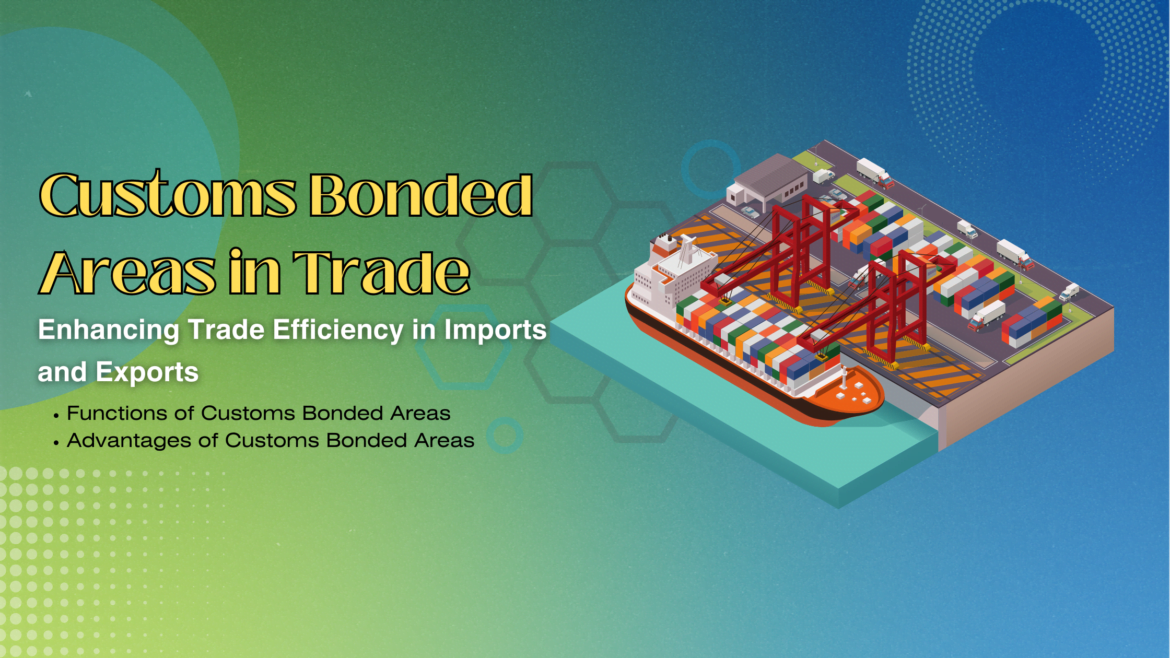Customs Bonded Areas in trade, customs procedures play a pivotal role in facilitating the smooth movement of goods across borders. Among the strategies designed to streamline trade operations, customs bonded areas stand out as key enablers. These designated zones offer unique advantages to importers and exporters, enhancing trade efficiency and promoting economic growth. The concept of customs bonded areas, exploring their benefits, functions, and contributions to the global supply chain.
Understanding Customs Bonded Areas
1. What are Customs Bonded Areas?
Customs bonded areas, also known as free trade zones or free zones, are specific geographic zones that exist within a country’s territory but are treated as if they are outside its customs jurisdiction. These areas are established to promote trade, investment, and economic activities by providing certain incentives and exemptions to businesses engaged in import and export activities.
2. Functions of Customs Bonded Areas:
Customs bonded areas, also known as free trade zones or free zones, serve as specialized zones within a country’s territory that are designated to facilitate international trade, attract investments, and promote economic activities. These areas offer a range of functions that contribute to trade efficiency, economic growth, and value-added services. Let’s explore these functions in more detail:
i. Duty Deferral:
One of the fundamental functions of customs bonded areas is the duty deferral mechanism. Goods entering these zones are not subject to customs duties or taxes at the time of entry. Instead, customs duties and taxes are deferred until the goods leave the bonded area for domestic consumption or export. This deferral allows businesses to manage their cash flow more effectively by postponing the payment of duties until the goods are ready for distribution or sale.
ii. Value-Added Services:
Customs bonded areas offer a platform for businesses to engage in value-added activities such as manufacturing, processing, assembly, testing, and packaging. These value-added services contribute to enhancing the quality and value of products before they are introduced into the market. Businesses can transform raw materials or semi-finished goods into finished products within the bonded area, benefiting from the availability of infrastructure and facilities tailored for such activities.
iii. Trade Facilitation:
One of the primary purposes of customs bonded areas is to streamline trade processes and reduce bureaucratic obstacles. Businesses operating within these zones can store, process, and re-export goods without the full range of customs procedures that apply to goods moving across international borders. This trade facilitation mechanism enables faster and more efficient movement of goods, ultimately reducing lead times and enhancing supply chain efficiency.
iv. Export-Oriented Production:
Customs bonded areas encourage export-oriented production by providing an environment conducive to manufacturing and assembly activities. Businesses within these zones can take advantage of reduced production costs, specialized labor, and infrastructure, allowing them to produce goods for international markets at a competitive price point. This focus on export-oriented production enhances a country’s capacity to tap into global demand and increase its export volumes.
v. Attracting Foreign Investment:
Customs bonded areas serve as attractive destinations for foreign direct investment (FDI). The advantages of deferred customs duties, streamlined trade processes, and access to specialized infrastructure encourage foreign investors to set up operations within these zones. The presence of foreign investment fosters economic growth, job creation, and technology transfer, contributing to the overall development of the country.
vi. Economic Diversification:
By promoting a diverse range of industries and activities, customs bonded areas contribute to economic diversification. These zones become hubs for innovation, research and development, and specialized production. As various industries thrive within these areas, the economy becomes less reliant on a single sector, reducing vulnerability to economic fluctuations and enhancing overall resilience.
Advantages of Customs Bonded Areas
1. Duty Savings:
One of the primary benefits of customs bonded areas is the deferred payment of customs duties and taxes. Businesses can defer these payments until goods are transferred to the domestic market, allowing for improved cash flow and financial management.
2. Trade Facilitation:
Customs bonded areas streamline trade processes by reducing bureaucratic hurdles. Businesses can store, process, and re-export goods without the constraints of full customs procedures at every step.
3. Export-Oriented Production:
Customs bonded areas encourage export-oriented production by providing a conducive environment for manufacturing and value-added activities. Businesses can benefit from reduced production costs and increased competitiveness in international markets.
4. Attracting Foreign Investment:
These zones attract foreign investment by offering a business-friendly environment, infrastructure, and regulatory framework that facilitate international trade. Foreign investors are more likely to set up operations in areas that provide such advantages.
5. Economic Diversification:
Customs bonded areas contribute to economic diversification by promoting industries and activities that generate employment and add value to the economy. These areas can become hubs for innovation and specialized production.
Customs bonded areas play a pivotal role in enhancing trade efficiency, promoting investment, and driving economic growth. By creating an environment conducive to manufacturing, assembly, and international trade, these zones contribute to the seamless movement of goods across borders. The advantages of deferred customs duties, streamlined trade processes, and export-oriented production attract businesses seeking to optimize their global supply chain operations.
For importers and exporters, customs bonded areas offer an opportunity to leverage incentives, reduce costs, and access international markets with greater ease. As international trade continues to evolve, these designated zones remain essential in fostering collaboration between governments and businesses to create a thriving global trading ecosystem.


1 comment
[…] Customs Bonded Areas in trade […]